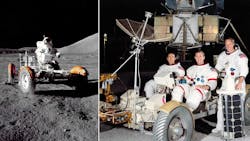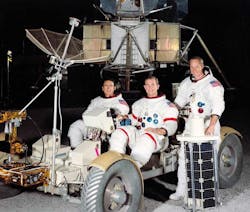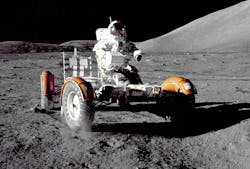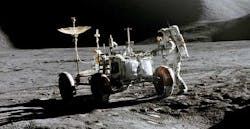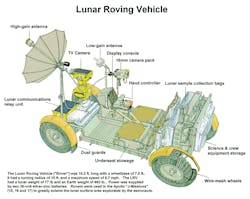Remembering NASA’s Lunar Roving Vehicle: An Interview
It’s been 50 years since NASA’s Apollo 15 mission to the moon, which was the first time the space agency included a Lunar Roving Vehicle (LRV) in the mission. The electric “moon buggy” could carry two astronauts and let them explore a larger area of the moon than they ever could have done on foot. To commemorate and chronicle the importance of the LRV to those last three Apollo missions, (Apollo 15, 16 and 17), author Earl Swift spent more than year researching and writing a book, Across the Airless Wilds: The Lunar Rover and the Triumph of the Final Moon Landings, which has just been published.
He answered some of Machine Design’s questions regarding the LRV project and what they meant to the Apollo program.Machine Design: What were two or three of the major engineering challenges in designing and building the LRV? How were those challenges addressed?
Earl Swift: It’s a challenge to settle on just two or three challenges, but I’ll go with weight, size and reliability. First, the rover had to be insanely light; NASA’s rule of thumb was that every 10 lb added to the lunar module that would shuttle astronauts and cargo to and from the orbiting Lunar Command Module would cost a second’s worth of fuel for hovering while attempting to land on the moon. So, keeping the weight down was a high priority.
NASA stipulated that the LRV couldn’t top 400 lb, which was about the same weight (on Earth) as a single astronaut suited up for a stroll on the moon. Boeing and GM, which won the contract to design and build the LRV, never quite reached that goal. Even after engineers trimmed every ounce of “fat” from the design, the finished LRV still weighed 462 to 470 lb.
Given the materials available in 1969 when the design was done, the tricks contractors and NASA used to save weight were remarkable. For example, they took advantage of moon’s low gravity, which is one-sixth that of Earth’s. The floorboards were only one-fiftieth of an inch thick and would snap under an astronaut’s weight on Earth. The seats were little more than beach chair. The “tires” were stainless steel wire mesh and would have been squashed flat if the LRV was driven on Earth. And the four electric motors, one for each wheel, churned out a total on one horsepower, which is just enough power to only run a decent shop vac at home but plenty to drive an LRV, which would weigh just 78 lb on the moon.
The lunar module had just one available cargo bay on its descent stage for the LRV. Its cargo capacity was about the size and wedge shape of a pup tent standing on its end. So, before NASA even green-lighted the project, it fell to Ferenc Pavlics, a GM engineer in Santa Barbara, to figure out how to origami a functioning LRV into such a small, oddly shaped space.
That engineer figured out how to hinge the rover’s frame so that it folded in on itself, then how to hinge the wheel and suspension assemblies so that they’d fold inward over the folded frame. It made a tight, tidy bundle that could be shoehorned into the cargo bay.
Once unfolded, the rover was still a small vehicle. A modern Mazda MX-5 Miata is about 2.5 ft longer.
Reliability was the other major challenge, which was addressed in typical NASA fashion: It required redundancy for all key components. For example, the rover had a motor in each wheel hub. If one or even two failed, it could still limp back to base. It also had both front- and rear-wheel steering and could fully function even if it lost one or the other. And it carried two batteries, but needed just one at a time.
If a redundant backup wasn’t possible, the engineering teams relied on sturdy simplicity. The navigation gear, for example, was stripped down to the essentials: a single directional gyro mated to odometers in each wheel. If it failed, and there wasn’t much to fail, the astronauts could always just follow their tire tracks back to the lander.
MD: How was the rover attached to the lunar lander and then released/deployed on the surface of the Moon?
ES: The folded-up rover was held in place by a webwork of struts, walking hinges, pulleys, wires and braked reels, which together was called the Space Support Equipment (SSE). It went through a frenzied evolution during the rover’s development. The frenzy stemmed from Boeing and GM’s tight deadline of 17 months to design, test and build both the rover and its associated gear, including the SSE. Most Apollo equipment took three or four years to develop.
Boeing originally planned a semi-automatic system that would securely hold the LRV despite the rigors of launch, space flight and landing, then snap unfold rover and lower it to the surface with minimal astronaut participation. But try as it might through several iterations, the company never got the deployment to work as intended.
Eventually, with the help of engineers at the Marshall Space Flight Center, Boing perfected a manual system. It called for astronauts to pull on a couple of lines to lower the folded rover like a drawbridge. At a certain point in this descent, the rear wheels would spring free and the rear frame unfold and lock into place. With a little more pulling, the front wheels and frame would also spring free and the whole machine would be lowered to the surface of the moon. The entire process took about ten minutes.
After that, the astronauts would load their tools aboard, along with a TV camera remotely controlled from Mission Control. They’d attach the antennas and the box of communications gear that kept them in touch with Houston while they drove, then it was ready to go.
MD: Any idea what the estimates are for the cost of designing, building and then taking the rover to the Moon?
ES: The rovers were not an easy build. The weight requirements, the testing regimen and the hurry-up schedule all contributed to the project and more than doubled its budget to roughly $31.8 million (in 1971 dollars) for three LRVs, one for each of the remaining Apollo missions.
Now, that doesn’t include the many millions of dollars NASA spent sponsoring rover studies throughout the 1960s. Those studies produced nothing that looked like the finished article, but they did influence the final design in several ways. The cost estimate also doesn’t include the millions private companies spent researching travel on the moon.
Putting all that earlier work aside and sticking with just the rovers that NASA contracted for in 1969 and got in 1971, I figure each mile they traveled on the moon cost in the neighborhood of $4 million in today’s money.
MD: What scientific data/info did the rover let NASA collect that could not have been collected without the rover?
ES: The rover completely remade the Apollo missions to the moon. Consider that on the first three lunar landings, astronauts walked everywhere they went. But walking and moving in a space suit was taxing and they carried a limited supply of air and cooling water in their backpacks, so astronauts couldn’t travel too far. Apollo 11 astronaut’s travels, for example, would fit inside a football field, with plenty of room to spare. The Apollo 12 astronauts wandered about 1.4 miles, but never got beyond sight of the lander. And Apollo 14’s moonwalkers, while hiking a little shy of two miles, never strayed much more than a half-mile from their lander.
The rather tiny pieces of real estate the earlier moon missions covered yielded limited returns in the geologic samples they brought back. Put another way, the astronauts on each mission picked up a lot of the same sort of stuff. Every moon rock was precious, but crews lacked the time and range needed to explore and sample a wide variety of the lunar surface.
That all changed with Apollo 15. It let the crew, Dave Scott and Jim Irwin, travel more than 17 miles across the moon’s Hadley-Apennine region, which is some rough country. They drove hundreds of feet up the side of a mountain that would rank among the greatest on Earth, cruised along the lip of a canyon almost a mile wide and a 1,000-ft deep, and collected geologic samples from sites scattered across an undulating plain called, rather ominously, the Marsh of Decay.
The last two missions were equally wide-ranging, thanks to their LRV. In all, astronauts drove 56 miles on the moon. And after the success of Apollo 15, NASA’s mission planners designed the crews’ extravehicular activities, or EVAs, around the rover’s capabilities: The LM would land in a spot from which the astronauts could drive to several different types of moonscapes, including craters, plains, ridges and mountains to collect samples.
On Apollo 17, Gene Cernan and Jack Schmitt drove for an hour across a plain, up a sloping avalanche fan, over a ridgelike scarp and down the other side, finally stopping just shy of five miles from their lander. Think about that: They were an hour’s drive from their one-way ticket home and well beyond sight of it. That moment, to me, marks the most extreme point of exploration we’ve managed as a species. They were out at the edge of the edge.
Range wasn’t the only advantage of using LRVs. Space suits then were pressurized and strenuous to move around in, making even simple chores exhausting. Working or walking in them raised an astronauts’ metabolic rates, which meant they breathed heavier and generated more heat, and thus tore through their backpack’s supplies of air and cooling water. LRVs not only relieved astronauts of the effort of traveling from one sampling site to another, it also let sit-down and rest during those explorations. This let them conserve life-support resources so they could work longer outside the lunar module.
Apollo 15 also introduced an improved backpack and space suit that were used on the last three missions. Those improvements included an increase in the air supply, which, combined with the LRV, added vital hours to the astronauts’ workday.
MD: Why didn’t NASA send unmanned rovers to explore the moon, as it does now with rovers it sends to Mars?
ES: I think what you’re asking is the age-old question of whether it makes good sense, economic or otherwise, to send manned missions on jobs that might be done robotically. For many missions, perhaps most, it probably makes sense to rely on machines. They’re a lot less expensive, a lot simpler, too, in terms of engineering and design. Using robotic rovers also means no human lives are at stake—a major advantage in its own right—but it also lets NASA redefine risk in mission planning and push the edge more aggressively.
That said, astronauts will tell you, and I tend to agree, that there are some missions on which there’s simply no substitute for having a set of human eyes on site attached to a human brain that can instantly analyze and react to what those eyes are taking in.
So, do I think the rover was worth the money? It “made” the missions, as Apollo boss Rocco Petrone said at the time. And each rover cost of about $13 million, which would be sky-high for a normal car, but was a pittance next to the $450 million each of the last three Apollo missions cost. The LRVs that changed everything cost less than 3% of the tab for all three missions. So, yes, I think it was money well spent.
